Content
- 1 Why eggshells are useful for the garden
- 2 Raw material collection rules
- 3 How to make eggshell fertilizer
- 4 When can you put eggshells under the plants
- 5 How to use egg shells in the garden
- 6 How to use eggshells for indoor plants
- 7 Where else can you apply eggshells in the garden
- 8 What plants should not be applied to eggshells
- 9 Pros and cons of using eggshells in the garden
- 10 Storage rules for raw materials
- 11 Conclusion
Egg shells for the garden are natural organic raw materials. When it gets into the soil, it saturates it with important substances and microelements. Egg fertilizer is suitable for garden and indoor plants, except for those that require acidic soil. The product helps to protect green spaces from pests and diseases.
Why eggshells are useful for the garden
Eggshell, as a fertilizer for the garden, enriches the soil, helps to reduce the acidity of the substrate. This natural material helps to fight insects, is suitable for soil mulching, is used during sowing and planting of plants in spring, has a beneficial effect on the condition of garden and home flowers.

Eggshell - a natural source of calcium
The composition and value of the eggshell
In 1980, Candidate of Agricultural Sciences A. L. Shtele deciphered the chemical composition of the shell.
In the course of research, the scientist found out that the shell of chicken eggs contains over 90% of an easily digestible substance - calcium carbonate and more than 20 other elements.
Chemical compounds that make up the shell of a chicken egg:
- magnesium;
- phosphorus;
- potassium;
- iron;
- fluorine;
- zinc;
- aluminum;
- silicon.
Mg deoxidizes the soil, enriches its composition, makes it lighter. Magnesium in combination with calcium, as well as nitrogen-phosphorus and potassium substances, is the main component necessary for plant nutrition. The substance lowers the acidity of the soil, improves its composition and structure.
Effects on soil and plants
Powdered eggshells provide plants with nutrients.
During the digging of the beds after harvesting, the coarsely crushed shell is mixed with the ground. The soil becomes looser, better air permeability.
The shell is indispensable for sandy soil due to Ca deficiency. The raw materials should be preheated in the oven.
What plants love eggshells
There are many vegetables, herbs, fruit trees and shrubs that respond to shelling with vigorous growth.
Eggshells applied as plant fertilizer increase crop yields, including:
- tomatoes;
- eggplant;
- swede;
- radish;
- pepper;
- melons;
- legumes;
- leafy vegetables.
Egg fertilization has a beneficial effect on the yield of garden crops (raspberries, black currants) and fruit trees (cherries, apple trees).

Egg fertilizer contains many minerals and trace elements
Raw material collection rules
The calcium source should be harvested during the cold season. Before the onset of winter, the chickens lay eggs protected by a stronger shell with a higher Ca content.
The largest amount of calcium is found in eggs with brown shells.
Boiled egg casings are less useful because they lose a lot of minerals during the heat treatment, but they can be used for soil mulching and pest control. The shells of boiled eggs must be removed from the layer of protein film to prevent the spread of bacteria.
Raw egg shells are ideal for use in containers for seed germination.
Raw materials from fresh eggs must be washed under the tap and dried by spreading them in a thin layer on paper.
The shells of boiled specimens can be dried immediately. To save space, the husk must be crushed and sent to a storage container. Waste should be kept in a cool dry place until sowing.
Large and hard shells can be used as seedling containers. They need to be washed and dried. To avoid brittleness, fill with cotton wool and put in a box.
How to make eggshell fertilizer
In order for natural fertilizer to bring maximum benefits to plants, it is important to know how to prepare it. The shell can be crushed to varying degrees of grinding or made into an infusion.
Grinding
Before use, the raw material should be crushed. The fineness depends on the intended use. Washed and dried shells can be processed in a coffee grinder, mortar, or blender. You can use a hammer and rolling pin and roll it over a hard surface to grind it into flour.
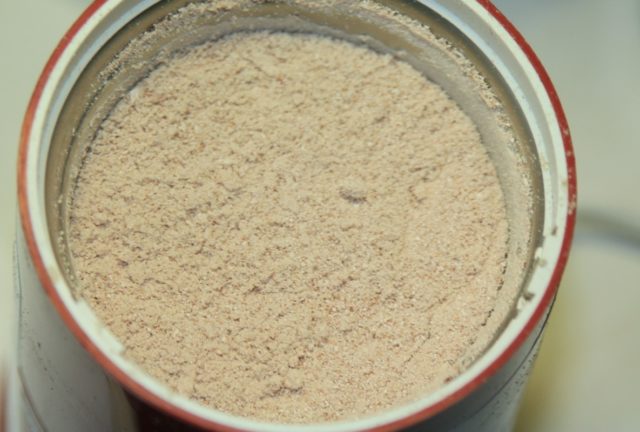
Milled shells quickly release nutrients to the soil
Infusion
Organic fertilizer can be prepared as an infusion. To do this, you need 1 liter and a shell of 5-6 eggs.
Cooking process:
- After breaking, the casings must be washed from the protein and dried.
- Then grind the prepared material to a powder consistency.
- Pour raw materials into 1 liter of boiling water and leave to infuse for a week. Stir the solution during preparation.
The finished infusion will have the appearance of serum, a pungent odor and a layer of foam on the surface.
For one feeding you need to take 1 tbsp. l. composition and stir it in a glass of water with a volume of 200 g. Fertilize with a break of 2-3 weeks.

Egg fertilization increases fertility and normalizes soil pH
When can you put eggshells under the plants
Egg waste is introduced into the soil in spring during sowing and planting of plants. In the midst of flowering, green spaces need potassium and calcium. Adding fertilizer when digging up ridges before cold weather improves the soil. During the winter period, the shell gives up its nutrients to the soil and by the spring the soil becomes ready for new plantings.
How to use egg shells in the garden
Eggshells are good for plants because they contain all the minerals they need. It is easy to digest and has a positive effect on plant growth, greenery and root crops formation.
The use of eggshells as fertilizer in the vegetable garden and in the garden
Recycled chicken shells, when dropped into the ground, make them more fertile and lighter.
There are several ways to use natural calcium fertilizer in the garden:
- Egg flour. When sowing, sprinkle the seeds with it and mulch. They are added to the ground in 1-2 items / 1 sq. m. The volume of the additive is increased to 1 kg / sq. m., if the substrate is highly acidic (for lightness of the soil). Also, the tool is used to protect against garden pests and diseases.
- Infusion. The shells of 5-6 eggs are poured with water and infused until a characteristic odor appears. The diluted composition is watered with garden crops at the root.
- Use of husk. To deoxidize the soil and remove excess water, large pieces of husk are placed on the bottom of the pot / container. Do this for better drainage of seedlings and houseplants.
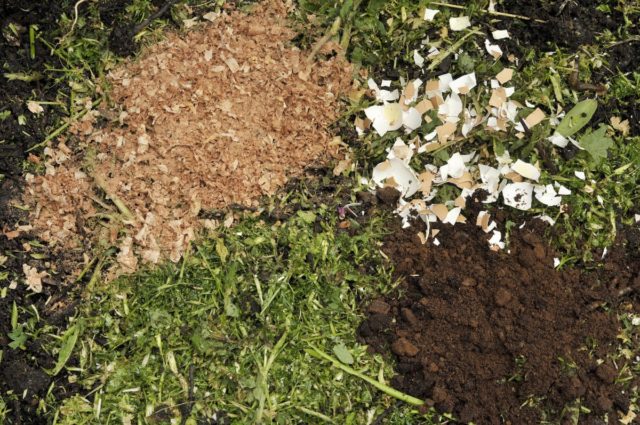
The shell is introduced into the ground from early spring to late autumn.
Fertilizing eggshells of vegetable crops
Ground egg waste is added when planting potatoes, onions and carrots.
Infusion is poured over seedlings of eggplants, peppers and root crops. The ratio of solution and water is 1: 3.
The calcium-containing fertilizer will please tomatoes and cucumbers.
Methods for introducing eggshells for tomatoes:
- introduction of the substance into the substrate;
- solution;
- sowing seeds in shells;
- drainage;
- sprinkling tomato greens for disease prevention.
During the season, eggshells should be added at 300 g-1 kg / 1 sq. m. area.
If there are not many shells, it can be poured under the roots of the tomatoes.
Calcium is necessary for tomatoes from the beginning of the growing season. Also, this element contributes to the formation and development of fruits.
Ca gives a good start to the development of cucumbers. Fertilizing is done after planting seedlings in the beds. During the period of intensive growth, calcium entering the soil from the shell promotes the development of roots, stems and leaves, and helps cucumbers withstand environmental influences.
Seedlings can be fed with infusion. The calcium-rich liquid accelerates seed germination, stimulates leaf development, metabolic processes and photosynthesis.
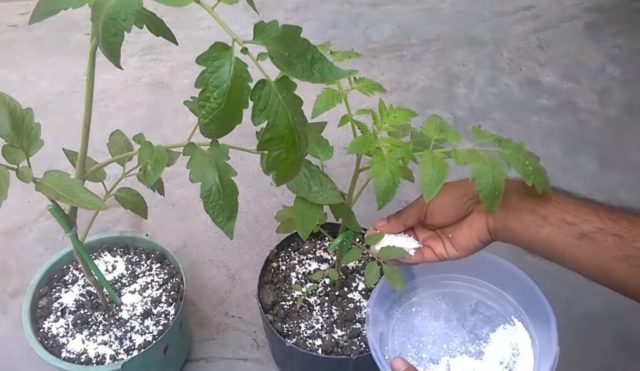
Root feeding of vegetable crops saturates the plants with calcium
Egg shells as fertilizer for fruit and berry crops
Garden fruit crops need calcium. Stone fruit trees: plum, cherry, bird cherry intensively use the reserves of this substance from the soil during the formation of the core of the fruit. This also applies to pome fruits: apple, pear, quince.
It is necessary to bring the shell under the fruit trees along the perimeter of the crowns, where the roots are.
Crushed shells are poured under the strawberries as a protective layer against the appearance of weeds and the invasion of slugs, snails, or they are applied throughout the garden bed as part of the compost. Organic fertilization increases the fertility of the substrate.
Sandy and clayey soil requires organic additives to increase fertility.
How to fertilize garden flowers with eggshells
Egg fertilization contributes to the full development of garden flowers, makes their stems and leaves more powerful, and the flowers - large. Plants are watered with infusion of shells several times a month. For small bushes, take 1/2 cup of solution, larger ones - 0.5 liters each.
Feeding eggshells of ornamental plants
Ornamental plants are planted to decorate the garden. These can be flowers, shrubs and trees.
Light soil is an important condition for the full development of such flora representatives as:
- lilac;
- hydrangea;
- rosehip;
- jasmine;
- forsythia.
These plants are planted and transplanted in spring or autumn. Egg shells of coarse grinding are laid on the bottom of the holes, as a drain, or mixed with soil for better air access to the roots. Calcium fertilizer is also applied as part of humus.
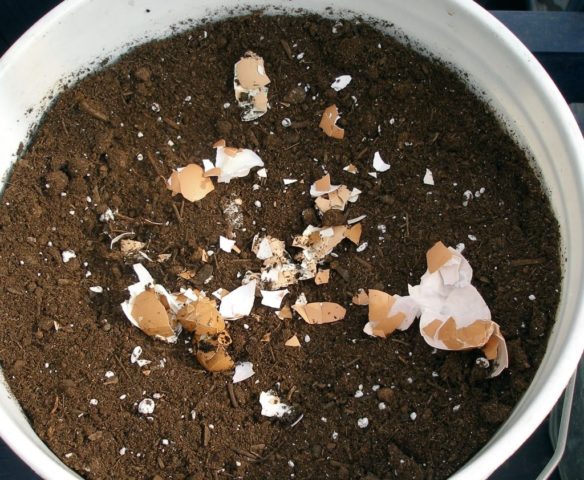
The shell of chicken eggs has a positive effect on fruit trees, garden crops and ornamental plants
How to use eggshells for indoor plants
Eggshells for indoor flowers can be used as an infusion. Watering home flowers with a diluted solution 1-2 times a month.
Coarsely ground fragments are used as drainage. A small amount of raw materials (up to 2 cm) is placed on the bottom of the pot and covered with earth.
Powder can also be added to the soil (1/3 teaspoon per pot).
Where else can you apply eggshells in the garden
The husk of chicken eggs has a beneficial effect on planting, not only when laid in the substrate, but also when applied externally. It is used to mulch ridges, to activate seed germination or to protect against pests.
For soil deoxidation
In order to deoxidize the substrate, 1-2 glasses of ground shells are added per 1 sq. m. area.
For mulching the beds
For mulching the surface of the substrate, coarsely ground shells are used. They are solid, therefore they fulfill their function for a long time. The protective layer prevents the soil from drying out and the growth of weeds near cultivated plantings, saturates the soil with vitamins.
For growing strong seedlings
Calcium carbonate, which is rich in egg shells, activates the proteins in the seed. They sprout quickly and become powerful.
The shell is ground into flour and sprinkled with seeds introduced into moist soil. Then fall asleep with a layer of substrate.
This method is universal for seeds sown on site or in a seedling box.
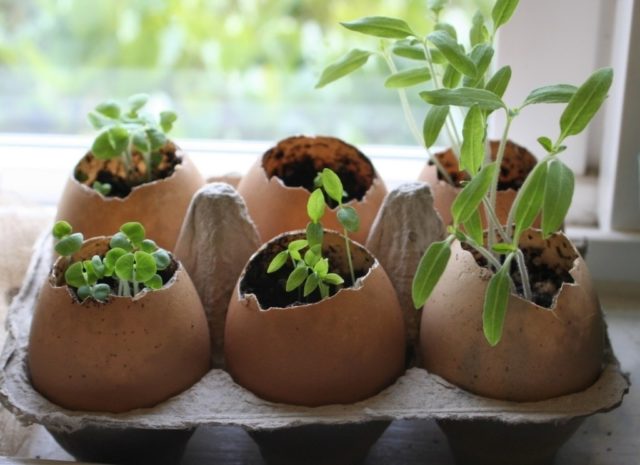
Eggshells can be used as containers for growing seedlings
For pest and disease control
Waste eggs will help protect plants from pests and diseases.
The use of the shell when planting or sowing provides plants with trace elements and protects against pests - bears, moles and mice. It is enough to add 1 tbsp. l. per hole.
It is worth using eggshells in the garden if the plantings are threatened by:
- slugs and snails;
- bear;
- Colorado beetle;
- butterflies;
- moles and mice.
To combat moles, coarsely ground fertilizer is applied to the ground.
The death of the bear is caused by eggshells mixed with vegetable oil. The raw material is buried in the soil between the rows. Adults and larvae of the Colorado potato beetle will dry out if sprinkled with shell flour.
From the snails, sprinkle the surface of the earth with pieces of egg shells.
When growing seedlings, the shell protects the plants from the black leg. To do this, you need to grind the shells to the consistency of sand and fill the soil surface in boxes or pots.
Whole casings hung among the cabbage ridge can scare away butterflies.

Egg shells protect garden plants from pests
What plants should not be applied to eggshells
There are garden and houseplants that love acidic soil, and egg feeding will disrupt their growth.
Houseplants that do not need to be fed with chicken egg waste:
- gloxinia;
- violet;
- camellia;
- azalea;
- pelargonium;
- hydrangea;
- gardenia.
Excess calcium can lead to illness.
Horticultural crops that do not need shelling:
- zucchini;
- strawberries;
- cabbage;
- spinach;
- beans.
Pros and cons of using eggshells in the garden
Egg waste is a natural source of calcium for plants. Fertilizer can be easily prepared, processed and applied to the soil. It will enrich the substrate and repel pests.
But you need to observe the dosage and know when and how to feed the plants.
An excessive amount of fertilizer applied to the soil can lead to an increased concentration of calcium in the aboveground parts of plants and their fruits. Plantings will receive less other nutrients from the soil. As a result, the growth and process of fruit formation will slow down. It is important not to overfeed the seedlings with egg fertilizer.

Due to its strong structure, the shell does not rot for a long time, therefore it reliably protects the soil
Storage rules for raw materials
If the shell is cleaned of protein and dried properly, it will not have an unpleasant odor. It can be poured into a cardboard box and kept in a cool dry place.
You cannot store the husk in a plastic bag, otherwise the raw material may deteriorate if moisture gets inside.
Conclusion
Eggshells for the garden are a simple and affordable way to improve soil fertility. This organic product is ideal for removing soil acidity and protecting crops from pests and diseases. The main thing is to properly dry the raw materials, prepare fertilizer, observe the dosage and apply it to the ground at the right time.








